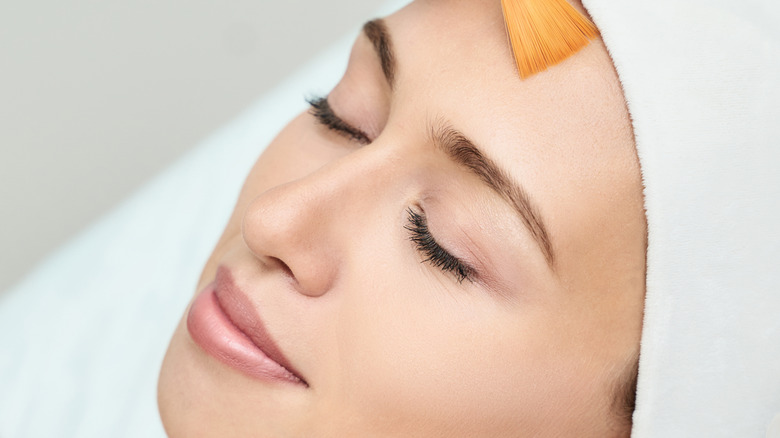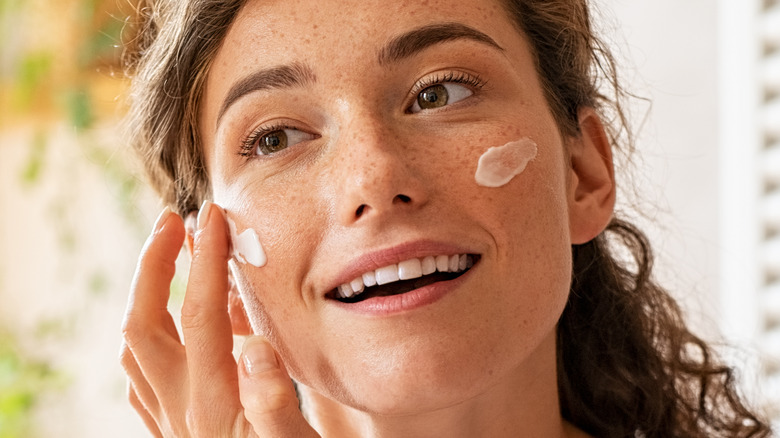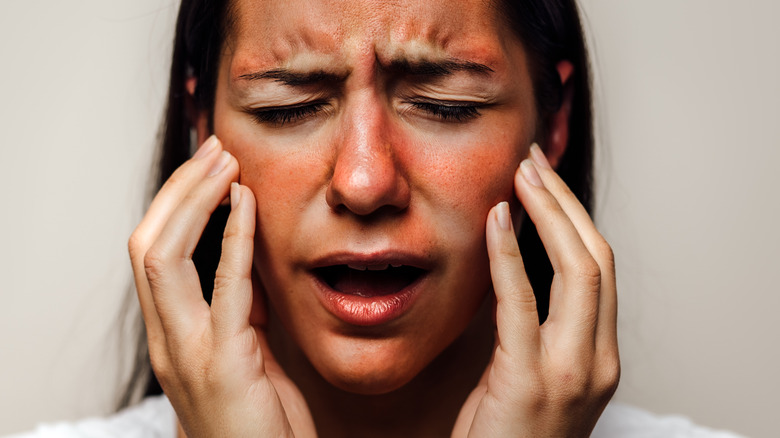Gommage: Your Guide To The French Exfoliating Method
Exfoliation is an essential part of any skincare routine. "We need to slough off or exfoliate the dead skin because we don't want dirt, grime, and bacteria on the surface," explains Glenise Gomez, skincare educator from Heyday. "[Dead skin cells] cause us to have impacted pores, acne, and congestion. In some cases, if we don't exfoliate properly, it will actually make us look older."
According to Dermafix, exfoliation takes three main forms: physical exfoliation, chemical exfoliation, and mechanical exfoliation. Physical exfoliation refers to the removal of dead skin cells from the skin surface by the use of a scrub or dry brush. Chemical exfoliation entails the use of enzymes and chemical components with exfoliating effects (like chemical peels) to break down dead skin cells. Mechanical exfoliation is when you use a device to slough off dead skin cells.
Another less-known exfoliation technique that has been trending in recent years is gommage. Hailing from France, this method of exfoliation is said to be gentler on the skin compared to traditional methods while effectively sloughing dead skin cells off of the skin's surface to keep the pores clean. Needless to say, gommage is all the rage with skincare fans who are tired of post-exfoliation irritation. Here's what to know about gommage, the next big thing in the world of skincare.
What is gommage
Edyta Jarosz, an esthetician at Shafer Clinic, claims that "gommage," which translates to "erase," dates back to the 1700s. Marie Antoinette, the last queen of France, employed this exfoliation technique to create a face mask, using eggs, cognac, powdered milk, and lemon juice. "Gommage is a French technique of gentle exfoliation," Jarosz tells mindbodygreen. "It uses a combination of ingredients that exfoliate your skin chemically through the combination of enzymes and scrubbing to slough away dead skin and other debris from the surface of the skin."
In other words, gommage carries the benefits of both chemical exfoliation through the use of enzymes and physical exfoliation through manual massage to buff away dead skin cells. Although it involves some rubbing and flaking, this French exfoliation technique doesn't use grainy exfoliating formulations like coffee grounds, microcrystals, and jojoba beads commonly found in typical physical exfoliation methods. It also doesn't employ exfoliating acids, common ingredients in chemical solutions that can potentially irritate sensitive skin. This is why gommage is considered a more gentle form of exfoliation for facial skin compared to traditional exfoliation methods.
How to exfoliate the skin with gommage
Gommage products typically feature enzyme-rich formulations obtained from plant and fruit sources that contain proteolytic effects, meaning they can dissolve the proteins that make up these cells to facilitate easy removal of them from the skin's surface, dermatologist Tiffany Libby tells mindbodygreen. Some of the most commonly used enzymes in gommage include papain, bromelain, pancreatin, and trypsin.
"Traditional formulations for gommage-type exfoliators are creams, pastes, liquids or gels that are allowed to dry completely once applied," dermatologist and CEO of Curology Dr. David Lortscher tells Skincare.com by L'Oréal. After washing your face, spread gommage over your damp skin, and let the product sit on your face for a while. Once the formula has dried into a solid paste, gently rub the applied area with your fingers until the product comes off in flakes, taking with it dead skin cells and impurities. Then, rinse away the product and follow with a moisturizer. According to Dr. Lortscher, you can start using facial gommage once per week to give your skin time to adjust to the product. If your skin reacts well to it, you can increase the frequency to twice a week.
Who could benefit from gommage
Gommage can unclog pores, stimulate collagen production, reduce acne, and facilitate better product penetration without compromising the skin barrier, dermatologist Loretta Ciraldo tells Real Simple.
Since a gommage peel is gentle and soothing, it's a good exfoliating option for sensitive or dry skin. "Gommage peels are typically a gentle cream texture — many of them have hydrating ingredients working simultaneously," aesthetician and founder of La Suite Skincare Rhea Souhleris tells Into The Gloss. However, a gommage is not for everyone.
If you have active acne (swelling, solid bumps with or without pus) Dr. Souhleris advises against a gommage peel, as the friction from the rubbing motion can potentially spread bacteria from the infected pore to the pores nearby and exacerbate your breakout. Gommage exfoliation is not a good idea for those with rosacea, either.
If your face is prone to peach fuzz, you might want to opt for wash-off products like an exfoliating facial cleanser to avoid a painful face wax. "The gommage can adhere to the hair," explains Souhleris, "making removal quite difficult and sometimes painful."
Potential side effects of gommage
Although gommage products are often promoted as gentler substitutes for conventional exfoliants, they are not without potential side effects. According to Healthline, some side effects that you can expect from gommage include redness, peeling, inflammation, and even pain. Since gommage exfoliants consist of enzymes derived from plants, check the ingredients on the label and consult your dermatologist for expert advice first if you're allergic to any fruits or plants.
For instance, papain, a proteolytic enzyme derived from the papaya fruit and a common ingredient in gommage exfoliation, may cause allergic reactions as well as induce allergic reactions, per a 2015 study published in the Journal of Investigative Dermatology. The study states that papain, when topically applied, can have an adverse effect on the skin barrier by boosting transepidermal water loss, degrading tight junction proteins, and inducing increases in skin blood flow and sweating. "People with sensitive skin, as well as small children, should avoid the enzyme (EC Number 3.4.22.2) as much as possible and observe the ingredients declaration for consumer products as regulated by EU Directive 2000/13/EC," says the author of the study, physician Erika Jensen-Jarolim, in a review published in ScienceDaily.
Gommage has certain limitations
Gommage exfoliation is relatively safe and a good option for those who want to exfoliate regularly. However, if you need a stronger exfoliant that delivers targeted and long-term benefits, you might need to resort to traditional exfoliation methods.
For instance, both enzymes and AHAs, such as glycolic and lactic acids, are forms of chemical exfoliation, but acids can reach living cells underneath the skin while enzymes may only scratch the surface. "Glycolic peels penetrate deeper into the epidermis than enzyme peels do," Dr. Souhleris tells Into The Gloss. While gommage peels may help with hydration, they don't provide the skin with the same benefits as AHA peels, such as enhancing hyperpigmentation, minimizing the appearance of pores, promoting collagen production, and restoring pH balance in the skin, explains dermatologist Dr. Jennifer Chwalek.
According to celebrity esthetician Lisa Guidi, owner of Erase Spa (via mindbodygreen), those with specific skin concerns like hyperpigmentation, sun damage, and active acne will reap more benefits from acid-based exfoliation that can promote cellular turnover for younger, stronger skin, such as AHAs and BHAs.





